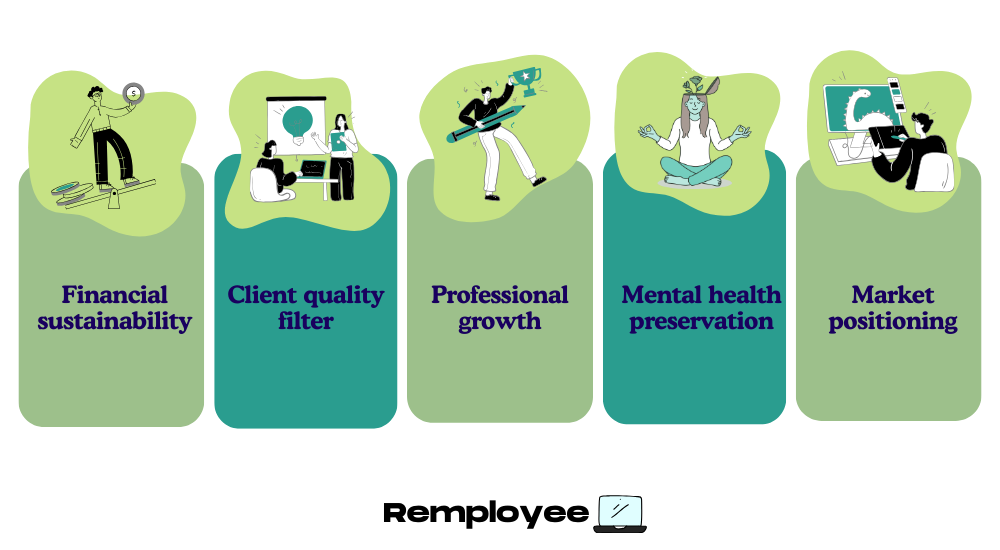Every freelancer knows that gut-punch moment when a client says your rate is “a bit high.” You’ve poured years into mastering your craft, delivered killer results, and yet here you are, defending why you deserve more than pocket change.
Most freelancers are charging McDonald’s prices for Michelin-star work.
It’s time to flip the script. Your expertise transforms businesses. Your work drives revenue. Your solutions save companies from expensive mistakes.
So why are you still apologizing for your rates?
This guide tears apart the freelance pricing playbook and rebuilds it around one principle: charging what you’re actually worth. No more racing to the bottom. No more feeling guilty about making good money.
Here are eight tips to help you negotiate your rates like you mean it.
Why is it important to set freelance rates correctly?

Setting correct freelance rates determines whether you thrive or slowly bleed out in the freelance universe. Price too low and you become the Universe’s favorite snack. Price right and you climb on top, taking reality for a ride.
Benefits of correct pricing:
- Financial sustainability: Cover expenses, save for emergencies, actually retire someday
- Client quality filter: Higher rates repel nightmare clients, attract serious players
- Professional growth: Reinvest profits into skills, tools, and business development
- Mental health preservation: End the feast-or-famine panic cycle
- Market positioning: Establish yourself as an expert, not a commodity
When you underprice, the spiral begins:
- Burnout acceleration: Working 80-hour weeks just to pay rent
- Resentment buildup: Hating clients who got premium work at discount prices
- Skill stagnation: No time or money for learning when you’re always grinding
- Business death: Eventually you can’t sustain it and return to employment
The math is unforgiving. Undercharge by 40% and you need almost double the clients to survive.
1. Research Freelance Rates in Your Niche
Start with platforms where your competitors live. Check Upwork profiles, LinkedIn rate cards, agency websites. Screenshot everything. Build a spreadsheet of reality, because reality beats fantasy every time.
The trick? Look for patterns in the chaos. Senior developers charging $150-200/hour. Junior copywriters at $50-75. Marketing consultants pulling $100-175. These numbers become your compass in the pricing wilderness.
Your research becomes ammunition. When clients question your rates, you have market data. You have proof. You transform from someone hoping for approval into someone who knows their coordinates in the freelance cosmos.
2. Set Your Value-Based Pricing Strategy
Value pricing means charging for transformation, for the client’s win. A website redesign that generates $50,000 in new revenue deserves more than $500. The ant climbs the skyscraper, and suddenly both have purpose through their intersection.
That’s why we built Remployee’s freelancer rate calculator – a completely free tool to simplify value calculations by tracking project outcomes and ROI metrics. Our calculator shows exactly how much revenue your work generates, turning abstract value into concrete numbers.
So, the math is brutal and beautiful. If you save a client 20 hours monthly at their $200/hour opportunity cost, you’ve created $4,000 in monthly value. Charging $2,000 makes you a bargain. Charging $500 makes you a fool.
Value pricing forces clients to see beyond hours into results. They stop counting minutes and start counting wins.
3. Choose Hourly, Project, or Retainer Pricing
The pricing model you pick determines your entire freelance existence. Each path leads somewhere different:
- Hourly: Trading time for money, capped potential, but simple to track
- Project-based: Freedom to work efficiently, rewards expertise over time
- Retainer: Predictable income, deeper client relationships, compound growth
- Hybrid models: Mix hourly for overflow, projects for core work
- Performance pricing: Share the wins, align incentives completely
Retainers create the closest thing to freelance nirvana. Predictable cash flow lets you plan beyond next week. Clients become partners. The hamster wheel slows down. But retainers require trust, and trust requires proof. Start with projects, prove your worth, then propose the retainer once they can’t imagine working without you.
4. Negotiate Confidently: Anchor High, Justify Value
Anchoring high rewires the entire negotiation. Start at $5,000 and suddenly $3,500 seems reasonable. Start at $2,000 and you’ll fight for $1,500. The Universe conspires to meet you where you set your coordinates.
The silence after stating your price feels like death. Every second stretches into eternity. But silence is your friend. It forces the client to process, to adjust their reality to yours.
5. Present Tiered Packages and Strategic Add-Ons
Three options hack the human brain. One feels limiting. Five overwhelms. Three creates choice without paralysis. The middle option becomes your anchor—where you actually want them to land.
The magic happens in the space between packages. Clients see the Essential lacks what they need. Premium feels excessive. Professional becomes the obvious choice—exactly where you wanted them all along. Add-ons let them customize without destroying your structure. The illusion of choice creates the reality of commitment.
6. Write Proposals That Frame ROI Clearly
ROI framing transforms proposals from expense requests into investment opportunities. Your proposal becomes the map showing them the treasure, the specific coordinates of their future success.
Lead with outcomes. “This project will reduce your customer acquisition cost by 35%” hits harder than “I will redesign your landing pages.” Numbers create reality. Specificity breeds belief. The client sees their future state and wants to get there.
Framework software like Better Proposals tracks proposal views and engagement, showing you exactly which ROI sections clients spend time reading. You learn what resonates. You iterate toward proposals that close themselves.
Every proposal needs three ROI anchors: time saved, revenue generated, costs reduced. Hit all three and the math does your selling. The client convinces themselves while you sleep.
7. Counter Client Lowball Offers with Proof
Lowball offers are tests. The client probes your confidence, checking if you believe your own price. Your response determines everything that follows.
- Document past wins: Screenshot testimonials, case studies, revenue increases
- Calculate opportunity cost: Show what choosing cheap actually costs long-term
- Reference market rates: “Similar projects in this space run $X to $Y”
- Demonstrate expertise markers: Certifications, years of experience, client logos
- Offer to walk: “I understand if that’s outside your budget range”
The walk-away is your nuclear option. State it calmly. Mean it completely. Half the time they find the budget. The other half, you dodge a nightmare client. Either outcome serves you.
8. Prevent Scope Creep with Clear Terms
Scope creep kills more freelance dreams than anything else. The project that started as a website becomes a website plus logo plus social media strategy plus tech support for life. You become the butter robot, existing only to serve an ever-expanding purpose.
So, most project overruns stem from unclear initial scope. The solution lives in radical specificity. Define everything. Document revisions. List exclusions explicitly.
Your contract becomes your fortress. “Additional requests beyond the defined scope will be quoted separately at $150/hour.” One sentence saves your sanity. The client knows the rules. You enforce them without guilt. The project stays profitable, and you stay sane.
Wrap up
Freelance pricing is your choice to make. The Universe hands you a blank canvas called “your rate” and waits to see what you’ll paint. Most freelancers paint themselves small, afraid to take up space.
But you’ve seen behind the curtain now. You know rates are quantum—they exist when you decide they exist. State your worth, back it with proof, and watch reality bend to meet you there.
Ben doesn’t buy into “the way it’s always been done.” He’s spent his career challenging hiring norms and rethinking how remote work should feel. At Remployee, he helps create honest tools and opportunities for people tired of the gig economy’s empty promises.



